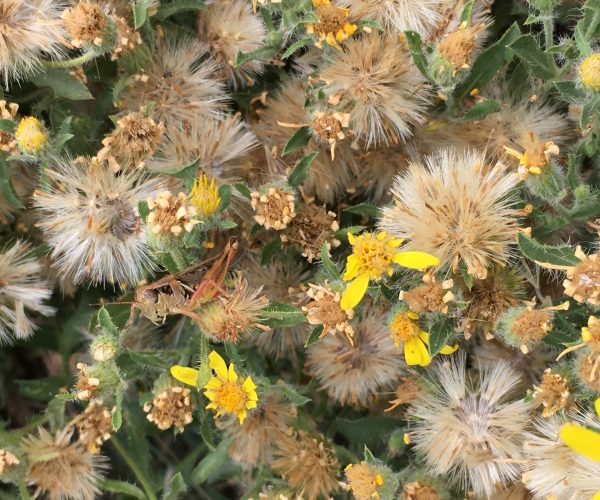In July, I learned a new meaning of heat. I read an article that stated that July in 2023 was the hottest month in recorded history, and that was absolutely the case here in Moab, Utah. Nevertheless, it was an exciting month full of new knowledge, birthdays (me and Mattie both celebrated July birthdays!), and new seeds to collect.
We wrapped up collecting our first target species, Hedysarum boreale, with a collection of over 300,000 seeds! We are now collecting our second target species, Heterotheca villosa, common name: hairy false goldenaster. This member of the asteraceae family produces small, yellow flowers with a center disk that produces a dark seed with fluffy, white hairs coming out from it that make it a lot of fun to collect. Since the seeds are much smaller and lighter than the last seeds we collected, it was fun to see how many more seeds we could fit in each paper bag for this species! It is quite satisfying to pinch the little puffballs of seed and see how many you can get per pinch.



Aside from our successes in seed collection, we also got to spend time with the hydrology team here working on a big fencing project at Medicine Lake in the La Sal Mountains. The fence that we helped to build will protect a wetland that has been harmed by hummocking by cattle. This project had so many different aspects that I got to be involved with and I learned so much! We built approximately half of the fence with barbed wire, T posts, and wooden stays and the other half was log worm fence reinforced with rebar.


My favorite aspect of this project was building beaver dam analogs, or BDAs. Essentially, a BDA is used to function in the same way that a beaver dam would, except that it is manmade. We constructed our BDAs using small aspen logs that get pounded vertically into the water channel, and many willow branches that get weaved in between each aspen log, much like weaving a basket. The goal of the BDAs in this project is to raise the water table in the wetland. We already noticed the water rising and spreading to different areas of the wetland from one day to the next which was super satisfying and made all the hard work worthwhile.

July has been incredible and filled with so many new experiences, and I can’t wait to see what August in Moab has in store for me. 🙂
